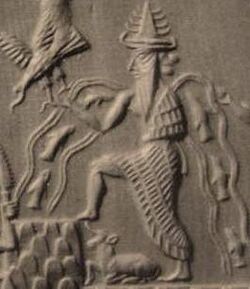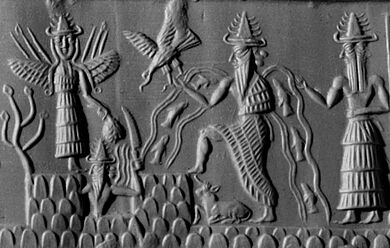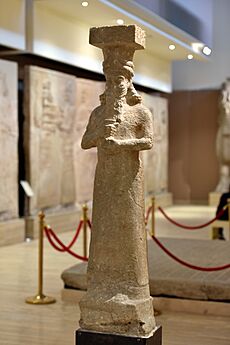Enki facts for kids
Quick facts for kids Enki𒀭𒂗𒆠 |
|
|---|---|
| God of creation, intelligence, crafts, fertility, magic, mischief | |

Detail of Enki from the Adda Seal, an ancient Akkadian cylinder seal dating to circa 2,300 BC
|
|
| Symbol | Goat, fish, goat-fish, chimera |
| Personal information | |
| Consort | Ninhursag, Damkina |
| Children | Marduk, Dumuzid, Ninsar, Ninkurra, Uttu, Ninti |
| Parents | An and Nammu |
| Siblings | Enlil |
| Equivalents | |
| Greek equivalent | Poseidon, Prometheus |
| Egyptian equivalent | Ptah |
Enki (Sumerian: 𒀭𒂗𒆠) was a very important god in ancient Sumer. He was known as the god of fresh water, wisdom, crafts, and creation. Enki was also one of the Anunnaki, a group of powerful gods.
Later, people in Akkadian and Babylonian cultures called him Ea (Akkadian: 𒀭𒂍𒀀). Some scholars also connect him to the god Ia in Canaanite religion.
Enki was first the special god of the city of Eridu. But his worship spread across Mesopotamia and to other groups like the Canaanites, Hittites, and Hurrians. He was linked to certain constellations in the sky. Starting around 2000 BCE, people sometimes used the number "40" to represent him. The planet Mercury was also connected to Enki in Sumerian times.
Many stories about Enki have been found. These stories come from places all over Southern Iraq and the Levantine coast. He is mentioned in some of the oldest writings from the region. Enki was a major god from ancient times until the Hellenistic period.
Contents
What Enki's Name Means
The exact meaning of Enki's name is not fully clear. A common translation is "Lord of the Earth." In Sumerian, En means "lord." Ki means "earth." However, some experts think ki might have a different meaning here.
The name Ea might come from the Hurrian language. Others believe it's from a Semitic language. In that case, it could mean "life" or "running water." In Sumerian, E-A means "the house of water." This might have been the name of his temple in Eridu.
Some believe the original god of Eridu was not Enki but Abzu. Abzu represented the underground waters. Later, Enki took over many of Abzu's roles.
Enki's Worship and Temples
Enki's main temple was called E-abzu. This means "abzu temple." It was a ziggurat temple surrounded by marshlands. This temple was located near the ancient Persian Gulf coastline at Eridu. It was the first known temple built in Southern Iraq.
Archaeologists have found evidence of a shrine there from over 6,500 years ago. Over 4,500 years, the temple was rebuilt and expanded 18 times. It was used until the Persian period.
The Enki temple had a pool of fresh water at its entrance. Many fish bones were found there, suggesting people had feasts. These features were later found in other Sumerian temples. This shows that Enki's temple set the pattern for many others.
How Enki Was Shown
Enki was the keeper of the divine powers called Me. These were like gifts of civilization. He is often shown wearing a horned crown, which showed he was a god.
On the Adda Seal, Enki is pictured with two streams of water flowing from his shoulders. These streams represent the Tigris and Euphrates rivers. Next to him are two trees, showing the male and female parts of nature. He wears a special skirt and a cone-shaped hat. An eagle is shown landing on his arm. This picture shows Enki as the god of water, life, and renewal.
Enki was seen as the master shaper of the world. He was also the god of wisdom and magic. He was known as the lord of the Abzu (Apsu in Akkadian). The Abzu was the freshwater sea or groundwater deep inside the earth.
In a later Babylonian story called Enûma Eliš, Abzu was the "father of the gods." He was disturbed by the younger gods and wanted to destroy them. But his grandson Enki put a spell on Abzu. This spell made Abzu fall into a deep sleep, trapping him underground. Enki then made his home "in the depths of the Abzu." So, Enki took on all of Abzu's powers, including his ability to bring life through water.
Early writings mention "the reeds of Enki." Reeds were important building materials. They were collected outside city walls, where the sick or dead were often taken. This connects Enki to the Kur or underworld in Sumerian mythology. In another old tradition, Nammu, the mother-goddess, was Enki's mother. She was seen as the watery creative force that existed before Enki.

Enki's Wide Influence
Enki, and later Ea, were sometimes shown as a man covered in fish skin. This image, along with his temple's name "house of the watery deep," shows his connection to water. Thousands of carp bones were found around his temple. This suggests people ate fish in feasts for the god.
His worship involved special ceremonies with water. This is also seen in the story of Enki and Ninhursag. This story explains how irrigation water made the dry land fertile. Early writings even suggest that Enki and Ninki were the parents of many other gods.
The pool at the front of Enki's temple was copied in other temples. It is believed that this tradition continues today. You can see similar sacred pools at Mosques or holy water fonts in churches.
Eridu remained a sacred city for a long time. Myths about Ea have been found in ancient libraries. As Ea, Enki had a big influence outside Sumer. He was linked to other gods like El in Canaanite stories. He also appears in Hurrian and Hittite myths as a god of agreements. He was often kind to humans.
Enki/Ea was a god of civilization, wisdom, and culture. He was also seen as the creator and protector of people and the world. Later, in the story of Marduk, Marduk is often called Ea's son. Marduk gets his powers from Ea. So, many prayers and songs for Ea were later changed to honor Marduk.
Enki held a permanent place as the third most important god in a group of three. The other two were Anu and Enlil. Enki controlled the water. He was called the "king of the Apsu," which was the deep water under the earth. He was also known as "lord of that which is below." This was different from Anu, who was the lord of the heavens.
Enki's worship spread throughout Babylonia and Assyria. Temples and shrines were built for him in many cities. He had many titles, showing how popular he was. Enki's partner was Damkina, also known as Ninhursag. She was originally equal to him. But in later times, she played a smaller role. Enki often preferred to solve problems through talking rather than fighting.
Ea and West Semitic Gods
In 1964, archaeologists found many ancient writings in the city of Ebla. They noticed that after the time of Sargon of Akkad, people in Ebla sometimes replaced the name of the god El with Ia.
Some scholars thought this Ia might be the Akkadian name Ea pronounced differently. However, most experts do not believe this Ia is the same as the Israelite god YHWH. Ia has also been compared to the Ugaritic god Yamm (meaning "Sea").
Ea was also known as Dagon and Uanna. Uanna was the first of the Seven Sages, who were wise beings.
See also
- Ancient Near East
- Azazel
- Barbar Temple, a temple in Bahrain for Enki
- Capricorn (astrology)
- Capricornus
- Iah
- Jah
- Me (mythology)
- Mesopotamian mythology
- Ahura Mazda
- El (deity)




